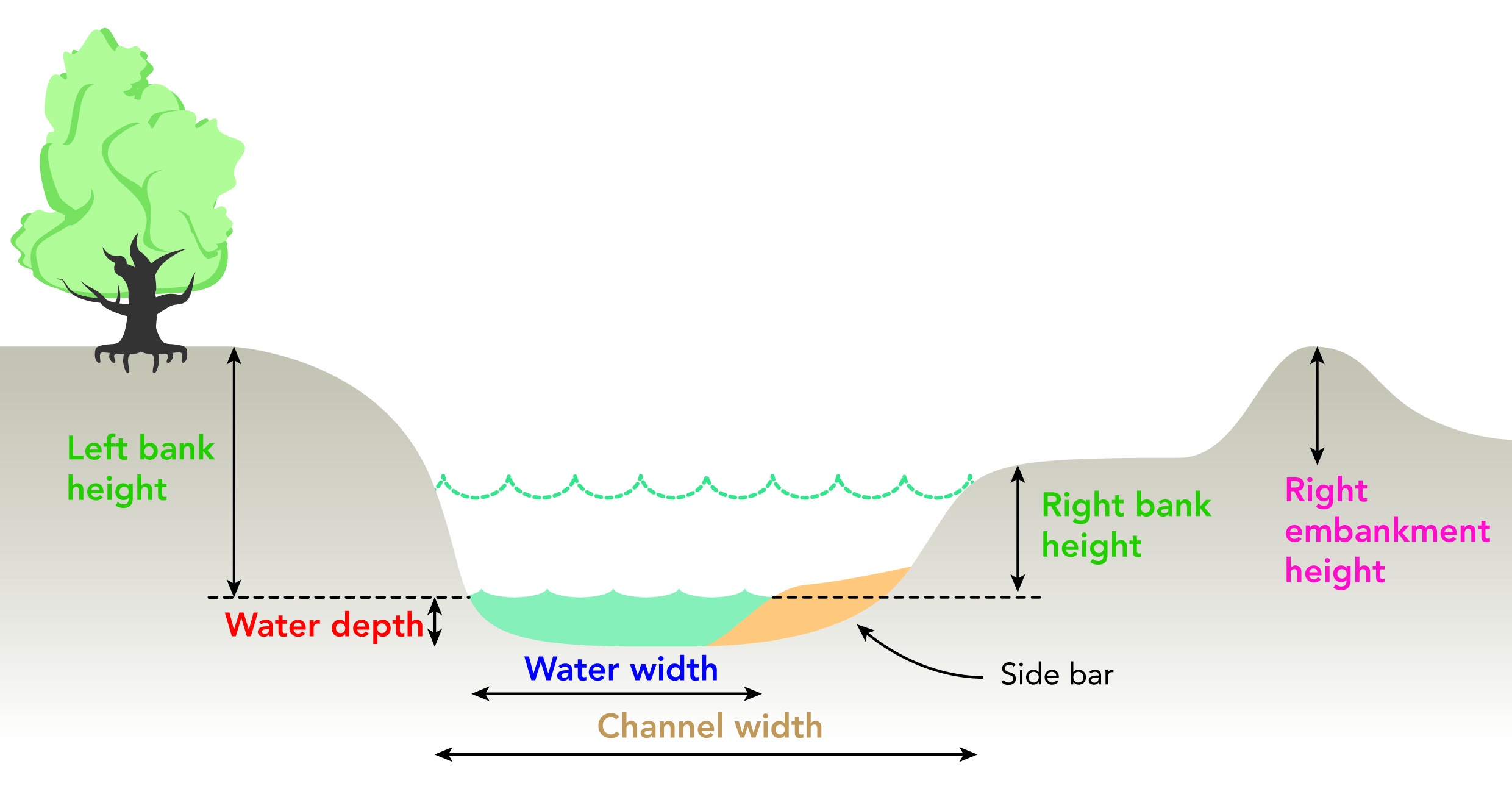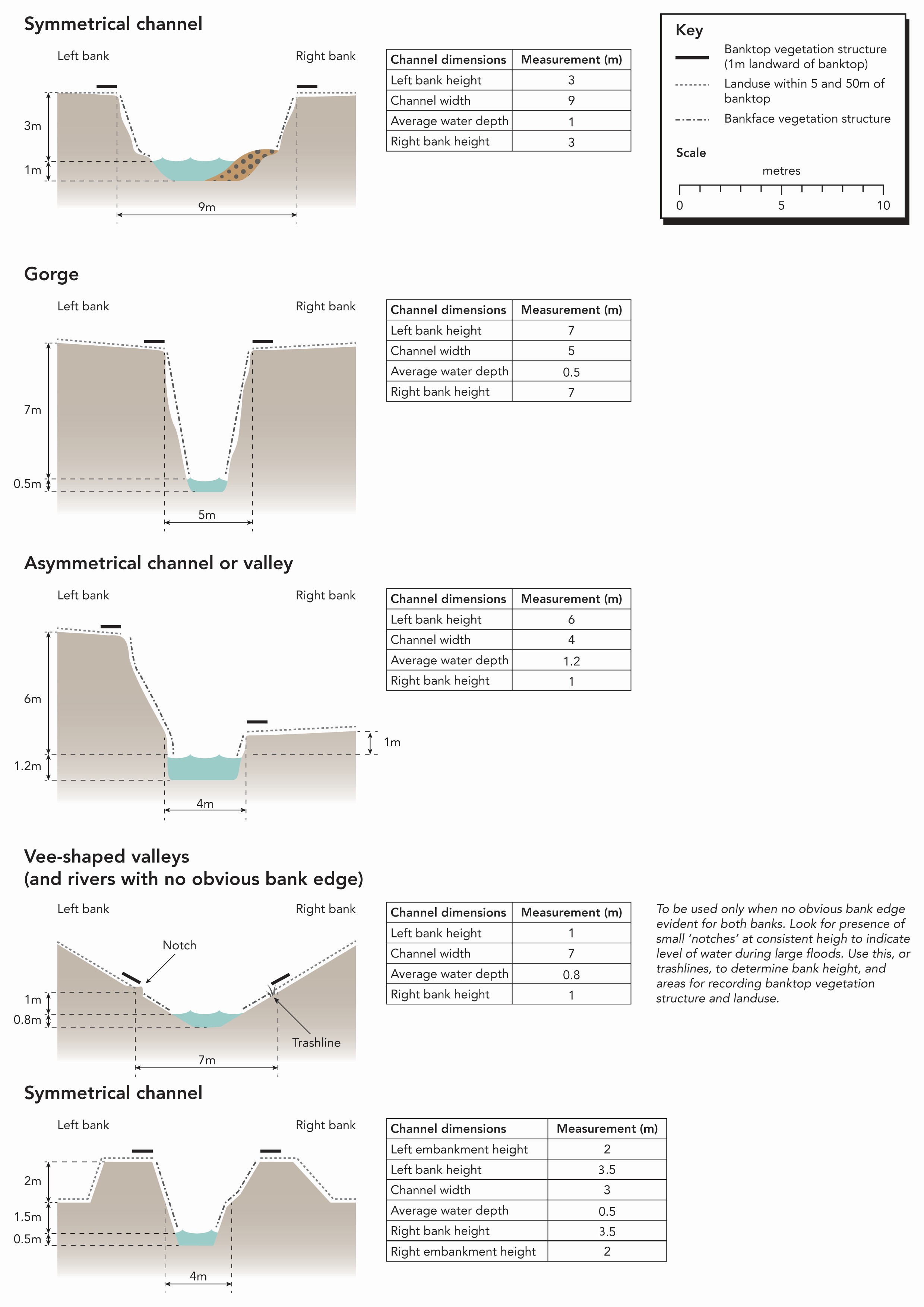Section L: Channel dimensions
SECTION L: CHANNEL DIMENSIONS

Make sure that it is safe to enter the channel to take measurements if needed. For large rivers where mid-channel water depth cannot be safely measured, enter “unknown” in the appropriate box.
Section L requires measurement of channel dimensions, including channel width, water depth and banktop height. Choose a straight part of the site if possible, preferably with well-defined banks and a riffle. This is the optimum location for measuring channel and bank dimensions. In many instances channel dimensions will need to be measured at a location other than at one of the spot-checks.
For guidance on banktop, water width etc., see the figure below. To ensure consistent recording it is imperative that surveyors fully comprehend this information before undertaking field measurements.
Both steep and very low gradient sites will not have riffles. In such cases choose a relatively uniform (and if possible, shallow) cross-section and state on the form the predominant flow-type at the location where channel dimensions are taken. In some instances, the river bed will be inaccessible and consequently water depth will not be determined. If so, indicate this on the form.
Rangefinders and ranging poles will improve the accuracy of measurements taken. Indicate how you measured the channel.
Measuring channel dimensions on braided channels can be very complicated due to the presence of several sub-channels. Water depth should be the average depth of water in the largest channel (i.e. the one from which flow-type and substrate are recorded in spot-checks), but water width cannot be measured. Banktop height and bankfull width should be measured using the banks abutting the floodplain.

Graphic Illustrating Channel Dimensions
Banktop height (m)
Banktop height is the vertical distance from water level, to the first major break in slope above which cultivation or development is possible. Use the ranging pole to estimate height (m).
Bankfull width (m)
Bankfull width is the horizontal distance across the channel to be measured at the level where the river first spills out of the channel on to the floodplain.
Where no distinct breaks in slope occur (e.g. streams in vee-shaped valleys or gorges), the bankfull height should be estimated using clues such as the winter flood level, often marked by a trashline, or ‘notches’ along the bank at similar heights to the trashline. Estimate bankfull width and height at this point: ENTER MEASUREMENT IN LINE FOUR – and do not enter bankfull width measurements in line one.
Is banktop height also bankfull height?
Bankfull height is the vertical distance from water level on the day, to the point where the river first spills out of its channel on to the floodplain (if it can). Indicate, using ‘yes’ or ‘no’, whether the bankfull height is equivalent to the banktop height.
Water width (m)
Water width is the distance across the wetted perimeter of the channel. Use the ranging pole to make crossing the watercourse in shallow locations safer, and use the pole to help measure the width. When a range-finder is used to measure channel width, indicate by adding (R) with the width measurement entry. Note on the form the max-min range of the range-finder used.
Beware: in misty conditions, or where the bank has a non-reflective substrate, accurate range-finder readings are difficult to get.
If it is impossible to wade safely across the river, and you do not have a range-finder, a reasonably accurate estimate can be made by sticking a ranging pole on the bank, and walking along the bank until the pole appears to be the same distance away as the far bank; pace the distance to the pole to estimate the channel width. Wherever possible, however, use a range-finder for measurements.
Water depth (m)
Water depth is the estimated average depth of the channel (to the nearest 10cm). Where possible, always try to estimate the actual depth, using the ranging pole; otherwise use “not known”. Common sense should prevail, but recording the average of three measurements taken across the depth range is good practice. If access to the channel is considered too risky, estimate the depth if feasible; if in doubt, record ‘NK’ in the box.
Embanked height (m)
Where embankments are present, record the extra height created by the embanked material. Include setback embankments where practicable.
Trashline height (m)
The height of the trashline above water level is to be recorded only if lower than the banktop. This may give an indication of an over-deepened channel with the ‘natural’ bankfull height, indicated by trashline marks. The width of the channel at the trashline height can be estimated and recorded. As the height of the trashline is dependent on the previous flood, measurement of this level provides less reliable information than bankfull and banktop heights and widths.
NOTE: Do not choose a location for channel measurements based on the presence or absence of a trashline.
River bed consolidation
Consolidated river bed material will be normally characterised by luxuriant bryophyte or rooted higher plant macrophyte growth. Where gravel and cobbles are present, these will be firmly inter-locked with other substrates, be hard to dislodge, and give a stable ‘feel’ when kicked.
Unconsolidated river bed material will comprise gravel, pebbles, cobbles or boulders which are not inter-locked and so are easily dislodged or moved when kicked.
In deep rivers where the channel cannot be safely accessed, record as ‘unknown’.
Location of measurements
Tick one of two boxes; if ‘other’ box ticked, enter the predominant flow type present across the channel where the measurements were taken.

Examples of channel dimension measurement